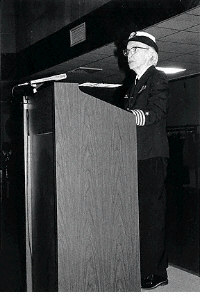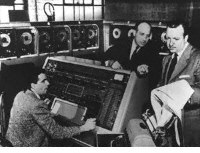









 |
|


 Grace Hopper
Grace Hopper
|
|
1945
On September 9th, Grace Hopper recorded the first actual computer actual
"bug" - a moth stuck between the relays and logged at 15:45 hours on
the Harvard Mark II. Hopper, a rear admiral in the U.S. Navy, enjoyed
successful careers in academia, business, and the military while making history
in the computer field. She helped program the Harvard Mark I and II and
developed the first compiler, A-0. Her subsequent work on programming
languages led to COBOL, a language specified to operate on machines of
different manufacturers.

|
|
|
|
|
1949
Thomas Watson Jr., speaking to an IBM sales meeting, predicted all moving
parts in machines would be replaced by electronics within a decade.

|
|
|
 Cronkite with UNIVAC
Cronkite with UNIVAC
|
|
1952
On election night, November 4, CBS News borrowed a UNIVAC to make a scientific
prediction of the outcome of the race for the presidency between Dwight D.
Eisenhower and Adlai Stevenson. The opinion polls predicted a landslide in
favor of Stevenson, but the UNIVAC's analysis of early returns showed a clear
victory for Eisenhower. Its sharp divergence from public opinion made
newscasters Walter Cronkite and Charles Collingwood question the validity of
the computer's forecast, so they postponed announcing UNIVAC's prediction
until very late.

|
|
|
 Alan Turing
Alan Turing
|
|
1954
Alan Turing was found dead at age 42. He had published his seminal paper,
"On Computable Numbers," in 1936, as well as posing significant
questions about judging "human intelligence" and programming and
working on the design of several computers during the course of his career.
A mathematical genius, Turing proved instrumental in code-breaking efforts
during World War II. His application of logic to that realm would emerge
even more significantly in his development of the concept of a "universal
machine."

|
|
|
|
|
1955
First meeting of SHARE, the IBM users group, convened. User groups became a
significant educational force allowing companies to communicate innovations and
users to trade information.

|
|
|
|
|
1970
Vietnam War protesters attacked university computer centers. At the University
of Wisconsin, the toll was one human and four machines.

|
|
|
|
|
1982
Time magazine altered its annual tradition of naming a "Man of the
Year," choosing instead to name the computer its "Machine of the
Year." In introducing the theme, Time publisher John A. Meyers wrote,
"Several human candidate might have represented 1982, but none
symbolized the past year more richly, or will be viewed by history as more
significant, than a machine: the computer."
His magazine, he explained, has chronicled the change in public opinion with
regard to computers. A senior writer contributed: "Computers were
once regarded as distant, ominous abstractions, like Big Brother. In 1982,
they truly became personalized, brought down to scale, so that people could
hold, prod and play with them." At Time, the main writer on the
project completed his work on a typewriter, but Meyers noted that the
magazine's newsroom would upgrade to word processors within a year.

|
|
|
|
|
1982
The use of computer-generated graphics in movies took a step forward with
Disney's release of "Tron." One of the first movies to use such
graphics, the plot of "Tron" also featured computers - it followed
the adventures of a hacker split into molecules and transported inside a
computer. Computer animation, done by III, Abel, MAGI, and Digital Effects,
accounted for about 30 minutes of the film.

|
|
|
 Gibson's Neuromancer
Gibson's Neuromancer
|
|
1984
In his novel "Neuromancer," William Gibson coined the term
"cyberspace." He also spawned a genre of fiction known as
"cyberpunk" in his book, which described a dark, complex future
filled with intelligent machines, computer viruses, and paranoia.
Gibson introduced cyberspace as: "A consensual hallucination
experienced daily by billions of legitimate operators, in every nation, by
children being taught mathematical concepts... A graphic representation of
data abstracted from the banks of every computer in the human system.
Unthinkable complexity. Lines of light ranged in the nonspace of the mind,
clusters and constellations of data. Like city lights,
receding..." (p. 51).

|
|
|
|
|
1988
Pixar's "Tin Toy" became the first computer-animated film to win an
Academy Award, taking the Oscar for best animated short film. A wind-up toy
first encountering a boisterous baby narrated "Tin Toy." To
illustrate the baby's facial expressions, programmers defined more than 40
facial muscles on the computer controlled by the animator.
Founded in 1986, one of Pixar's primary projects involved a renderer, called
Renderman, the standard for describing 3-D scenes. Renderman describes
objects, light sources, cameras, atmospheric effects, and other information so
that a scene can be rendered on a variety of systems. The company continued on
to other successes, including 1995's "Toy Story," the first
full-length feature film created entirely by computer animation.

|

|
|

|
|





